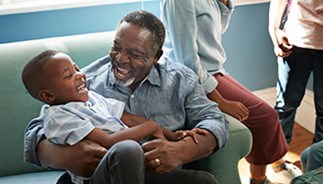How To Stop Cramps When Exercising
When you’re trying to exercise, the last thing you want is cramp preventing you from reaching that personal best.
These involuntary spasms can seemingly occur out of nowhere, sometimes even putting an abrupt end to your morning jog or evening gym session. But don’t worry, there are steps you can take to help prevent them from happening or quickly soothe any discomfort.
In this article, we’ll talk through what cramps are, why you get cramps, and what steps you can take to help stop them.
Jump to:
What are exercise-induced cramps?
5 ways to stop cramps
When to see a GP about muscle cramps
How can Benenden Health help?
What are exercise-induced cramps?
Exercise-induced cramps are an involuntary contraction of your muscles, causing pain and tightness in the affected area.
Cramps can affect any muscle, but the leg, foot, and calf muscles are most commonly impacted during exercise. While they typically only last for a few seconds, they can be quite painful, and you may notice the following symptoms:
A tight feeling in the area.
Muscle twitches or spasms.
Sudden pain in the muscle.
Difficulty moving the impacted limb.
Once the cramp has subsided, the area can feel sore or tender for a while. However, this will usually go away on its own within a couple hours.
Why do you get cramps while exercising?
While there are many different reasons why you might cramp up during exercising, overexertion is the most likely culprit. The exact reason this happens is unknown, but some studies do suggest it’s down to fatigue in the muscle.
You can also get cramp as a result of:
Not warming up properly for exercise.
Electrolyte imbalance.
Ageing
Drinking too much alcohol.
Pregnancy – typically during later stages.
A side effect of high blood pressure or cholesterol medication.
Exercising in hot or humid conditions can increase the risk of getting cramp when you’re working out.
No matter the cause, cramps will usually always go away on their own within a few seconds to 10 minutes, according to the NHS.
5 ways to stop cramps when exercising
1. Stretch your limbs properly
As overworking or straining your muscles is one of the most common cause of cramps in the legs, properly warming up and prepping for exercise can help reduce the risk.
There’s plenty of warm up routines you can try, but the NHS recommends the following calf-stretching routine for legs:
- Face a wall and stand up straight with your feet flat on the floor.
- Stretch out your arms until you’re able to touch the wall in front of you.
- Gently lean forward until you can feel a stretch in your calf muscles – hold this position for 3 seconds.
- Lean back from the wall and stand up straight.
- You can repeat these steps for five minutes each time, three times a day.
2. Eat a balanced diet
Eating a healthy, balanced diet is already important for overall health and wellbeing, but it can also be used to help prevent cramp during exercise.
More specifically, you want to include plenty of potassium, calcium, and magnesium in your diet, as the electrolytes they contain can help ward off muscle cramps. Your body needs electrolytes for everyday functions, but it also uses these electrically charged substances to help the muscles and nerves work properly.
Bananas are an excellent source of all three, but you can look to include more of the following foods as well:
- Sweet potato.
- Avocado.
- Melons.
- Kale.
- Spinach.
- Salmon.
- Milk.
- Orange juice
3. Drink plenty of water
In general, you should be drinking between six to eight glasses of water a day to stay healthy and hydrated. However, when you’re exercising, especially in hot or humid environments, you’ll likely need to drink even more than that to replace the lost fluids.
That’s because when exercising, you sweat as a natural reaction to regulate your body temperature. However, our bodies lose fluid and electrolytes when exercising, which can trigger cramps.
Whether going to the gym or running around the park, always make sure you have a bottle of water with you. You might find it helpful to pick up a reusable water bottle with marker lines on it, as this’ll help you keep track of how much water you’re drinking throughout the day.
4. Apply a hot or cold pad
To help relieve the discomfort of cramp, try applying a heating or cooling pad to the affected area.
Once the cramp has eased, you can apply a heat pad to relieve muscle tightness, and if your muscles feel sore, cold therapy is beneficial – both methods are helpful depending on how your muscles feel.
As both hot and cold pads help increase blood flow to the cramping muscles, it can help soothe the area, reduce inflammation, and bring down any swelling. While this won’t stop a leg cramp immediately, it’s an effective way of helping the muscle relax to reduce the pain.
Keep your heating or cooling pad on the cramping area for around 10 to 15 minutes, but don’t leave it on for longer than 20 minutes at a time as this can cause burn your skin. You can repeat this up to three times a day.
5. Massage the area
Massages are known for their muscle relaxing benefits, and this is no different when it comes to treating cramp.
This works in a similar way to applying a hot or cold pad – massaging helps increase blood flow to the area. As such, it can help relieve muscle tightness, tension, as well as decrease muscle fatigue, which is the potential cause for cramp in the first place.
To stop a cramp with a massage, gently rub the area in circular motions, applying subtle pressure with your fingertips as you go. Keep going until you feel a bit of pressure start to alleviate. You can repeat this as many times as is needed to relieve discomfort.
When to see a GP about muscle cramps
In most cases, you don’t need to worry about leg cramps or any other type of exercise-induced cramp. They’re quite common and will typically go away on their own. However, there are times where it may be best to see a GP.
According to the NHS, you should see your primary care clinician about cramps if you experience any of the following alongside the more common symptoms of cramp:
Leg cramps are starting to disrupt your sleep.
Your leg cramps come with numbness or swelling.
You get cramps that last longer than 10 minutes.
Your GP will be able to assess what’s causing your cramps and can help outline any necessary treatment plans.
It’s important to note you can get cramp in any active muscle when exercising. If you get cramp in your chest muscles, shoulders, jaw or arms then you need to see a clinician to investigate the cause.
How can Benenden Health help?
Wanting to keep fit and healthy? For more information on how to get healthy and fit outdoors or foods to eat before a workout, head over on our Be Healthy hub.
Plus, as a member of Benenden Health you can get access to a wide range of private healthcare services to help you look after your health and wellbeing. Access to The Benenden Health App, live and on-demand classes and our 24/7 GP Helpline from day one. Plus, after you’ve been a member for six month, you can use our Physiotherapy services, including guided self-managed exercise and face-to-face or virtual sessions with a physiotherapist to help you keep moving.
Medically reviewed by Dr Cheryl Lythgoe in July 2025.


